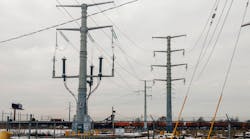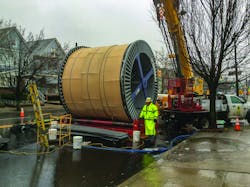Public Service Electric and Gas Co.’s complex Bergen-Linden Corridor project, placed into service in June 2018, required a high degree of collaboration and attention to detail to deliver the project successfully. PJM Interconnection, the independent regional transmission organization responsible for planning the transmission system in 13 states, ordered the utility to build the Bergen-Linden Corridor (BLC) to address high transmission system fault currents and overloads. Constructed in three phases, the US$1.2 billion project consisted of building new 345-kV stations as well as overhead and underground facilities in a 22-mile-long (35-km-long) corridor running from Bergen County, New Jersey, U.S., in the north, to Linden, New Jersey, in the central part of the state.
The first two phases were completed in 2016 and 2017 and included upgraded 20 circuit miles (32 km) of double-circuit overhead lines from 138 kV to 345 kV. The third phase involved constructing four new underground circuits in Bayonne, New Jersey, and Elizabeth, New Jersey, to create parallel paths between three existing substations and a new substation at the Newark Liberty International Airport. It also connected the facilities upgraded in the earlier phases. This phase also upgraded three existing 138-kV high-pressure, fluid-filled (HPFF) circuits to 345 kV, abandoned one existing 138-kV HPFF circuit and modified four other HPFF circuits within existing stations. During the design phase of BLC, a separate project was approved and executed to add a fifth underground circuit, further increasing transmission network reliability in the region.
While PSE&G had previously used HPFF-pipe type of cable for other recent underground projects, the utility looked at other available technologies such as cross-linked polyethylene (XLPE) cable for BLC. PSE&G asked its design engineer and engineer of record, POWER Engineers Inc., to present the pros and cons of the different cable technologies. Based on POWER’s analysis, PSE&G decided XLPE was the best option for this project.
Workable Routes
PSE&G and POWER applied the lessons they learned from other underground projects in planning BLC. Important steps to success included involving stakeholders upfront, quickly determining design criteria, and getting the routing studies and engineering done early. The dense populations of Elizabeth and Bayonne required the underground cable to thread through a complex network of water, gas and sewer lines as well as electric, television and telephone cables. It also meant digging up lots of road paving, rerouting traffic and making numerous crossings of the New Jersey Turnpike, railroad tracks and Newark Bay. PSE&G’s team needed to identify workable routes not only for transmission conduits but for 51 vaults that would each take up an 8-ft-wide by 30-ft-long (2.4-m-wide by 9.1-m-long) space in the roadway.
In Elizabeth, city sewers made of clay and brick required careful planning and construction considerations. In other cases, the underground route had to avoid disturbing open spaces, as part of a New Jersey program known as Green Acres.
During its comprehensive feasibility study for the project, POWER developed three alternative routes for each of the four circuits, estimated costs and assessed constructability, including the ability to obtain the necessary permits. Under the direction of PSE&G and POWER, a separate study of potential routes across the bay was developed. Burns & McDonnell served as the program manager for this important project. When finally designed, the underground project included 20.5 circuit miles (33 km) of 345-kV XLPE cable, the first on PSE&G’s system, and reconductored 6.2 circuit miles (10 circuit km) of older HPFF conductor with new transmission cable.
PSE&G’s mapping team conducted formal surveys for the project. The engineering and environmental consulting firm Haley & Aldrich Inc. devised a specialized drilling and sampling procedure for 168 soil borings ranging from between 15 ft and 80 ft (4.5 m and 24.4 m) deep. Geotechnical studies along the route typed soils, sampled concrete, installed temporary wells and sampled groundwater recharge rates. These steps helped the underground team to understand the challenges it faced and prepare more-informed bid documents. At critical points along the proposed routes, test pits were dug to confirm existing ground conditions, including utility depths and locations.
PSE&G competitively bid and awarded all civil work to a single local contractor, J. Fletcher Creamer & Son Inc. Using a single contractor enabled work crews to be used efficiently. If work hit a snag in a location, Creamer moved crews to work a section in another location. The strategy proved successful in keeping the project moving ahead, and civil work, which was expected to take almost two years, was completed in less than 11 months.
This careful planning and accelerated civil timeline enabled PSE&G to be more efficient in ordering the XLPE cable it needed. POWER identified the appropriate cutting lengths of cable for each reel, and the utility was able to order cable lengths based on the actual conduit length that connected one vault to another, eliminating excess scrap cable.
One particularly congested area along the underground project called for a unique solution. PSE&G’s Bayway substation sits in the shadow of the New Jersey Turnpike where it crosses the Elizabeth River. Conrail tracks parallel the turnpike at the river. To reach the substation, the 345-kV cable would need to cross the highway, conrail tracks and river. There simply was not enough room to bring the line into the substation underground. Instead, PSE&G and POWER decided to build a short section overhead and run it parallel to an existing 26-kV overhead line that already connected with the substation, crossing over the turnpike, tracks and river. POWER designed the underground-to-overhead transition structure, the first for a 345-kV line in the U.S., while PSE&G engineers designed the overhead line. This solved the constructability challenge posed by the numerous site constraints.
Newark Bay Crossing
PSE&G considered several ways of bringing the cable across Newark Bay, such as dredging and laying cable from a ship. However, the busy shipping lanes in the bay ruled out that option. While PSE&G had undertaken other horizontal directional drilling (HDD) projects, BLC’s Newark Bay crossing was, by far, its longest—and the longest HDD crossing of 345-kV XLPE circuits in North America.
The design of the HDD crossing began at the end of 2014, when PSE&G hired a local engineering company, MFS Engineers & Surveyors, to perform an HDD feasibility study. The study identified potential landing sites, performed geotechnical exploration, and developed the final conceptual plan and bid documents. Before HDD work could commence, PSE&G had to submit permit applications to various federal and state regulatory agencies, a process POWER and others supported by preparing and providing design drawings and technical information. All necessary permits were obtained in November 2016, and the HDD work commenced the following month. This left only 11 months to complete the work on schedule.
The HDD work required one boring for each of the two circuits, using four HDD rigs. Southeast Directional Drilling operated two rigs from Bayonne and two from Elizabeth, with each drill intersecting in the middle of the bay. Three different formations of hard rock converging beneath Newark Bay made the drilling more difficult.
The operators began by driving steel conductor casings down 270 ft (82 m) to bridge the area from the ground surface down to soils with a high bearing capacity. Then they used augers to remove the accumulated spoils from the interior of the casings. They installed a 16-inch-diameter (406-mm) centralizer pipe to center the drill stem used to complete the 11-inch-diameter (279-mm) pilot hole through the bedrock, to a depth of about 140 ft (142 m) below the mean high-water level of the bay.
The four rigs worked simultaneously while operators guided the gyroscope-equipped drill bits to meet somewhere in the middle, creating two continuous borings. Drilling operators then widened the pilot hole using progressively larger bits until the hole reached the targeted 48-inch (1.2-m) diameter. Crews pulled a 36-inch (0.9-m) casing through the bore hole. When the casing was in place, workers installed conduit bundles to house XLPE cables, which would be pulled in later. Crews installed thermal grout to remove heat caused by high-voltage power transmission, which helps to maintain the function and life span of the cables.
As the final borings neared completion in September 2017, barges brought in eight massive reels, each holding 5000 kcmil XLPE cable manufactured by LS Cable & System Ltd. The reels — which each held 6800 ft (2.07 km) of cable, long enough to reach from one end of the bay to the other — had a 12.5-ft (3.6-m) diameter, had a width of 25.5 ft (7.8 m) and weighed approximately 100 tons (90.7 metric tons) each.
Cable pulling and splicing finished up in spring 2018. The five new underground circuits and HPFF reconductors and relocations all were tested and placed in service prior to the project’s required June 2018 in-service date.
At a ceremony attended by PSE&G and its partners, the New Jersey Alliance for Action cited BLC as New Jersey’s leading infrastructure project, an award that recognizes innovative, pioneering and landmark construction initiatives that greatly affect the state’s economy.
“The success of the Newark Bay crossing and of the entire project is a tribute to exceptional teamwork on the part of all involved,” said John Ribardo, senior director at PSE&G. “From the beginning, we understood that success on this complex project depended on assembling a team of experts who could work well together and focus on getting the work done in a safe and timely manner. I thank all involved for their exceptional work.”
Ronald Shute ([email protected]) is director, outside plant construction and engineering at Public Service Electric and Gas Co.’s (PSE&G’s) delivery projects and construction organization. Shute served as project manager on the Bergen-Linden Corridor project, responsible for all underground transmission components of the project. He has extensive experience managing complex underground projects.
Dennis Johnson ([email protected]), of POWER Engineers Inc., has served as a design and project engineer on numerous substation, overhead and underground transmission projects at voltages ranging from 69 kV to 345 kV. He has been involved in various engineer-procure-construct projects. He is an active voting member of the IEEE Insulated Conductors Committee (ICC) and a member of various ICC subcommittees that are developing guides and standards for high-voltage underground cable systems. He has taught multiple seminars around the U.S. focusing on underground power systems.
Mohanbir S. Mehta ([email protected]), of POWER Enginers Inc., specializes in the management and execution of large program efforts in the power delivery industry, with project experience in the U.S., Canada, India, Middle East and other locations worldwide. His accomplishments include transmission line, substation, and supervisory control and data acquisition projects, including those involving advanced technologies such as static volt-ampere-reactive compensators, high-voltage direct-current and gas-insulated substations. He is skilled at navigating technically and logistically complex projects, coordinating multiple project participants, assembling and directing project execution teams and resolving conflicts for successful project completion.
For more information:
Burns & McDonnell | www.burnsmcd.com
Haley & Aldrich | www.haleyaldrich.com
J. Fletcher Creamer | www.jfcson.com
LS Cable & System | www.lscns.com
MFS Engineers & Surveyors | https://mfsengineers.com
POWER | www.powereng.com
PSE&G | https://nj.pseg.com
Southeast Directional Drilling | www.southeastdrilling.com






